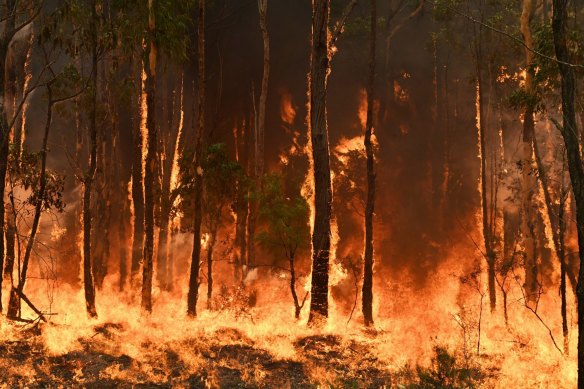Past Compliance: Enhancing Home Security with a Comprehensive BAL Report
Past Compliance: Enhancing Home Security with a Comprehensive BAL Report
Blog Article
Vital Tips for Bushfire Administration to Make Certain Fire Protection

Recognizing Bushfire Risk Degrees
Recognizing the varying levels of bushfire threat is essential for reliable planning and preparation in mitigating possible hazards to buildings and lives. Bushfire danger degrees are usually classified based on elements such as weather conditions, gas accessibility, topography, and historic fire habits. By comprehending these risk people, levels and neighborhoods can proactively apply techniques to lower vulnerability and boost strength despite prospective bushfire occasions.
The initial degree of bushfire danger is low risk, where the chance of a bushfire taking place and causing substantial harm is minimal. Risky degrees represent a substantial risk, with conditions conducive to quick fire spread and extreme fire habits.
Recognizing these bushfire danger levels makes it possible for stakeholders to customize their preparedness and reaction actions as necessary, making certain a reliable and aggressive method to bushfire monitoring.
Developing a Defensible Area
Effective bushfire monitoring starts with developing a defensible space around properties to improve protection versus possible fire hazards. A defensible room is a barrier area that develops a barrier in between a framework and the surrounding combustible vegetation. This space works as an essential line of defense, offering firemans a safe location to run and helping to minimize the danger of a fire infecting the home.
When developing a defensible room, it is necessary to think about the design of the residential property and the surrounding landscape. Cleaning plant life, specifically extremely combustible plants, within a specific radius of the residential or commercial property can help prevent the fast spread of fires. Furthermore, preserving a well-irrigated zone around the property can further enhance its defensibility.
Normal upkeep of the defensible space is important to ensure its efficiency. This consists of trimming overhanging branches, clearing dead vegetation, and maintaining the area devoid of particles. By spending effort and time into developing and maintaining a defensible area, home proprietors can significantly boost their possibilities of protecting their homes and properties throughout a bushfire.
Implementing Fire-Resistant Landscape Design
When developing landscapes to minimize the threat of bushfires, incorporating fire-resistant aspects is essential for boosting residential property protection and reducing fire hazards. Implementing fire-resistant landscaping involves tactical preparation to produce a defensible space around frameworks. Begin by selecting fireproof plant species that are less most likely to ignite and generate reduced degrees of flammable materials. Select plants with high dampness content, reduced oil content, and marginal dead vegetation to reduce the danger of fire spread. In addition, keep sufficient spacing in between plants and maintain them appropriately pruned to avoid fire from conveniently leaping between greenery.

Producing an Emergency Evacuation Plan
Developing a comprehensive emergency situation evacuation plan is critical for making certain the safety and security and wellness of individuals throughout possible bushfire occurrences (Bushfire Risk). An efficient emptying strategy need to detail clear treatments to adhere to in case of a bushfire hazard, including designated discharge paths, assembly points, and interaction procedures
To begin producing an emergency emptying plan, it is vital to evaluate the details threats and susceptabilities of your place. Determine numerous emptying routes that lead to risk-free areas far from the fire, considering factors such as surface, road accessibility, and possible threats. Establish interaction networks to alert homeowners of an approaching emptying, making use of techniques such as sirens, message signals, or door-to-door alerts.
On a regular basis evaluation and practice the evacuation strategy with all homeowners or area members to make certain everyone comprehends their roles and responsibilities. Conduct drills to check the performance of the plan and make any required adjustments. By having a well-prepared emptying strategy in position, you can enhance the possibilities of a risk-free and organized emptying during a bushfire emergency situation.
Keeping Fire Safety And Security Equipment
After establishing a thorough emergency situation discharge prepare for bushfire occurrences, it is vital to focus on the regular maintenance of fire security tools to make sure ideal performance and readiness. Normal maintenance of fire safety and security devices such as fire extinguishers, smoke alarm, fire alarms, and sprinkler systems is essential in guarding lives and building during a bushfire. When needed., performing regular examinations, screening, and maintenance of these tools by certified specialists is vital to assure they are in working order.
Fire extinguishers ought to be checked consistently for stress levels, visible damages, and correct capability. By diligently keeping fire safety devices, individuals can enhance their readiness and feedback capabilities in the occasion of a bushfire.
Final Thought
Finally, reliable bushfire management entails recognizing threat degrees, creating defensible spaces, applying fire-resistant landscape design, creating discharge plans, and preserving fire safety tools. By adhering to these crucial suggestions, individuals can make certain better fire defense and safety and security for their areas and properties. It is essential to prioritize proactive procedures to alleviate the threats associated with bushfires and to be prepared for emergencies.
By BAL Report comprehending the subtleties of bushfire threat levels, creating defensible areas, executing fire-resistant landscaping, developing comprehensive discharge strategies, and guaranteeing the upkeep of fire safety equipment, areas and people can significantly boost their strength versus the ravages of wildfires - BAL Report. These tips are not only important for guarding against prompt fire threats however additionally for fostering lasting fire protection methods that can make a significant distinction in the face of escalating bushfire threats
Risky levels symbolize a considerable danger, with problems conducive to fast fire spread and severe fire habits. Routine maintenance of fire safety and security equipment such as fire extinguishers, smoke detectors, fire alarms, and lawn sprinkler systems is crucial in protecting lives and building throughout a bushfire.In conclusion, effective bushfire management includes recognizing danger levels, developing defensible rooms, implementing fireproof landscape design, establishing evacuation plans, and keeping fire safety and security devices.
Report this page